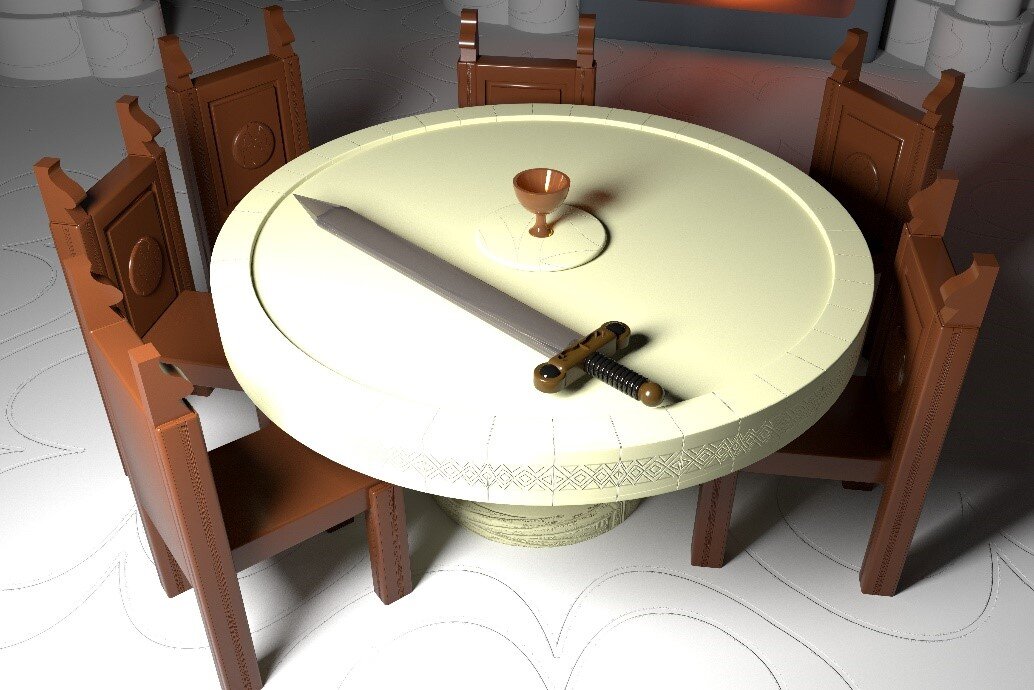The Art of Leadership
Picture a king.
Did you conjure an image of a mighty leader draped in finery, sitting high on a throne, towering over his subjects or a chairman sitting at the head of a long table, barking orders and gesturing imperiously to his cowed advisors?
This is the image many of us have of a leader. Whether in a board room, classroom, film set, capitol building, or laboratory—any place where teams work under the leadership of a designated director—we generally expect responsibility and power to be organized hierarchically.
While this is sometimes the case, it certainly doesn’t have to be. In my experience, the most effective results often come from structuring things differently, with an emphasis on collaboration, respect, and intentional designation of responsibility not according to power, but to strengths.
When King Arthur invited his knights to confer, he didn’t seat himself on a throne at the head of the room. He was comfortable and confident enough in his position as leader to seat them around him at a round table, where they were all on the same level and power was shared equally among them.
I once worked on a team that was tasked with managing and overseeing the design and construction of a major new plant.
The president of the company chose each one of us personally and slowly built his team. The Project Manager (PM)—let’s call him Jerry— was someone who had previously worked for me on another project that I was leading as VP Project Manager.
When assembling this new team, the president asked me directly if I would have a problem working for Jerry this time, and I told him I would have no problem.
I had to wear many hats. I was responsible for integrating the master schedule across three sister companies, identifying and mitigating potential risks, and overseeing our earned value metrics. But early on in our team’s process, I naturally started taking on the conventional tasks of the team leader as well.
Jerry and I hadn’t explicitly discussed this, but as longtime friends and colleagues, we had a mutual trust and understanding that offered us both the opportunity to play to our own strengths, and support the other in playing to his.
In Belbin language, my natural team roles are that of Shaper and Coordinator—roles that tend to drive and lead in the most obvious and conventionally understood ways. With natural strengths of Specialist and Team Worker, Jerry is much more detail-oriented and prefers cultivating strong one-on-one relationships. He favors harmony over conflict, and was perfectly content to let me take on some of the more contentious aspects of managing the team, while he got to smooth things over afterward and focus on mining his extensive expertise for the benefit of the team.
We were both happy and thriving in this dynamic. Perhaps it’s a testament to the mutual trust we’d built up over many years, but there was never any sense that I was undermining or challenging his authority as the PM. Rather, the whole team and our work flourished, since each member had the opportunity to play precisely to his or her strengths without feeling hamstrung by external expectations or conventional understanding of how things should be structured.
Contrary to popular opinion, true leadership does not always mean being in a strong power role, driving, pushing, and shepherding the flock. It means understanding where you sit most comfortably and naturally—your instinctive team roles and strengths—and building a circular table around you, then populating it with people who complement your strengths and embody all the necessary roles on any given team.
Jerry brought a subtle leadership style backed up by deep and thorough expertise to our team. He knew he needed someone hard-driving and results-focused sitting to his right—and he let me fill those roles and run with them. (You might say he let me be his Sir Lancelot.) That was perhaps one of his most inspired instances of leadership on this particular project.
We all knew who was in charge. There was never any doubt about who the PM was. But even though he wasn’t actively delegating, his confidence provided the inspiration to everyone else
on the team to fill the roles that came naturally to them, and thereby to add maximum value to the team’s work.
This is a model I believe in wholeheartedly and that Belbin actively enables. At Smartt Strategies, we’ve developed an approach for determining where you sit—identifying the specific team roles where you naturally shine—and for helping you build that table around yourself that you can populate to build the strongest, most effective, results-getting, high-performance team possible.
Because leadership isn’t about muscling your way to the head of the table. It’s a more subtle art, and it starts (as so many things do) with self-knowledge. Are you ready to build your round table?

